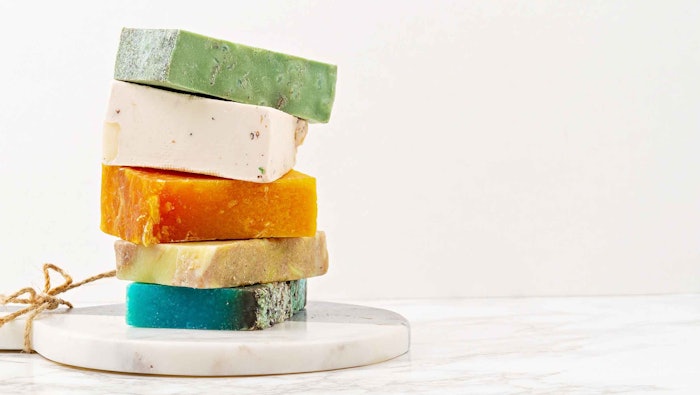
Sustainability has become an increasingly important topic in the beauty industry. Consumers have grown more conscious about their environmental impact, driving an urgent need to curb plastic pollution and subsequent demand for zero-waste packaging.1 Per Future Market Insights, the global zero-waste packaging market is expected to reach approximately US $2.5 billion by 2033 and expand at a CAGR of 8.8% from 2022 to 2032.2
Log in to view the full article
Sustainability has become an increasingly important topic in the beauty industry. Consumers have grown more conscious about their environmental impact, driving an urgent need to curb plastic pollution and subsequent demand for zero-waste packaging.1 Per Future Market Insights, the global zero-waste packaging market is expected to reach approximately US $2.5 billion by 2033 and expand at a CAGR of 8.8% from 2022 to 2032.2
Zero waste cosmetics help to address environmental concerns, as they are designed to minimize waste throughout a product’s life cycle; from production to disposal. This article will delve into the concept of zero waste beauty by exploring how brands like LUSH, Garnier (L’Oréal), Ethique and the author’s own, Beauty Kitchen, have embraced this sustainable approach. It also will explore formulating considerations of solid product formats.
Zero Waste Efforts
While the industry has made strides, conventionally, many cosmetics come with excessive packaging, leading to unnecessary waste that ends up in landfills or pollutes the oceans. By shifting toward zero waste products, companies and consumers can reduce their environmental footprint and promote a more sustainable future, which in turn leads to a circular business model where there is huge opportunity to reinvent our industry.
Zero waste generally refers to the goal of eliminating waste entirely – or at least significantly reducing it. For Beauty Kitchen, this means minimizing cosmetics and personal care packaging; for example, a shampoo bar in a small box rather than liquid shampoo in a 250-mL plastic container. This is exemplified by the company’s Bars Not Bottles collection.
Beauty Kitchen also previously established a “return, refill and repeat” system,3 partnering with different collaborators to set up 100 refill stations in the UK to dispense shampoo, body wash, conditioner, hand wash and facial cleanser products. Unilever partnered with Beauty Kitchen as well to dispense several of its products. Beauty Kitchen collects empty packaging from customers to clean and reuse it for some products, and 32 of its products are Cradle to Cradle certified for their re-usable material content and circular design.4
LUSH has pushed this even further. Of its all-year-round product range, 65% of products are sold “naked,” with no packaging, in addition to products being based on sustainable ingredients. The products that are in pots and bottles are sold in 100% post-consumer plastic, and those pots and bottles can be returned to any LUSH store to be chipped down and remolded into new pots and bottles, closing the recycling loop.5
Furthermore, some LUSH products are packaged in 100% biodegradable and compostable cellophane or wrapped in reusable fabric knot wraps. In addition, 100% biodegradable plant-based packing peanuts are used to ship gifts and online orders.5
L’Oréal’s Garnier brand has set a goal that by 2025, it will only use plastic packaging made from zero virgin plastic, and all plastic packaging will be reusable, recyclable or compostable. Today, the plastic bottles used in Garnier’s Organic range are made of 100% recycled plastic, and by 2021, in Europe and the United States, the brand’s Ultimate Blends shampoo bottles will be made of 100% recycled plastic. Garnier additionally launched its Whole Blends line of shampoo bars that use zero plastic packaging.6
Ethique’s hair, body and skin care bars are packaged in paper to omit plastic waste. Per the brand, water usage to create the paper was minimized – and what water was used was recirculated and recycled during the paper production. The brand also recently introduced zero waste lip balms, packaged in compostable cardboard tubes.7
Solid Format Benefits
Solid format formulations offer an approach to beauty and personal care products that virtually eliminates the need for water in product formulations, in addition to offering savings in plastic packaging and logistics. A significant portion of most liquid shampoos (approx. 80%) and conditioners (up to 95%) is water, which requires larger-volume packaging and more fuel to deliver the products. Solid products are akin to concentrated versions of their liquid counterparts, boasting high amounts of active ingredients with little to no water – which also alleviates the pressure on our increasingly scarce water sources.
The environmental benefits of solid format formulations are manifold. Since they do not require packaging, they significantly reduce waste. Considering their concentrated nature, they also can last longer than liquid products and thereby reduce the frequency of purchase and associated carbon footprint; one survey conducted by Ethique found this extended longevity to be the case.8
The benefits of bars answer the growing consumer demand for sustainable, eco-friendly products. One research firm reported the global market for shampoo bars was valued at US $10.8 million in 2022, which is projected to surge to $19.7 million by the end of 2031, at a 7% CAGR.9
With the market for bars and solid products trending upward, it will be important for formulators to understand how to approach this solid product format, in addition to distinctions between and among types. These formulating considerations are outlined in the next section.
Types of Solid Formulations
Solid cosmetics can be categorized by their base (lipophilic or hydrophilic) and their level of aggregation, i.e., loose powder, bath bomb, bar, stick, cake, tablet, etc. Lipid-based formats, such as skin care sticks and balms, use combinations of waxes, oils and butters to create a solid texture that melts at body temperature, forming a soft film on the skin. This format is popular for products like solid fragrances, lotion bars, lip balms and even stick foundations.
On the other hand, solid formats with a polar base can be formulated using polar, wax-like ingredients that provide a solid structure while retaining their hydrophilic nature. Soap bars and syndet bars (synthetic detergent bars) fall into this category and are ideal for products that require lathering or emulsifying; e.g., shampoo and conditioner bars.
Loose and pressed powders offer another solid product form. Loose powders can be more difficult to handle and dose than pressed powders, although the latter require an applicator for delivery.
Distinctive Composition of Solid Formulas
Contrary to common belief, solid format formulas are not merely solidified versions of liquid products. Their smaller, more concentrated form requires a different formulating strategy. For example, preservative systems or active ingredients must be adapted to the product’s low water content and highly concentrated form, respectively. Solid products also must give the consumer a perceived high value, since they are smaller and compared by the consumer with larger volumes of liquid products (thanks to their higher water content).
Solid shampoos and conditioners are also not the same as traditional soap bars. They are formulated with surfactants that work well in a solid format and are gentler on the hair and skin. There are two distinct categories of bars: soap-based and surfactant- (or detergent) based. Despite their resemblances in appearance and shared ingredients, the two function quite differently.
To know which type is appropriate for a given application, it is important to consider pH levels. As a quick review, it is well-known that the pH scale determines the acidity or alkalinity of a product and ranges from 0 to 14. Acids such as citric are lower than 7 (~pH 2) and bases such as drain cleaner are higher (~pH 14). Skin naturally maintains an acidic state, or “acid mantle,” typically between 4 and 5.5.
Soap-based bars: Soap-based shampoo bars are created using oils mixed with sodium hydroxide, an alkaline ingredient with a high pH value of 14. After the oils are saponified, this alkaline nature decreases but still retains a level within the range of 8-10. Such bars are not advisable for hair, although they can be used on the body. This is because skin can naturally restore its natural acidic levels.
To use a soap-based shampoo bar on hair, one should follow with an acidic rinse. This helps to restore hair's natural acidity levels. Failing to incorporate this step may result in coarse-feeling hair that lacks the desired softness and smoothness since using an alkaline product on hair causes the cuticles to lift and become swollen. This makes hair more vulnerable to breakage and damage.
One possible solution would be to add citric acid to the bar, as it acts as a pH regulator to bring down the formula's acidity level. However, if one is making soap via a cold process with raw sodium hydroxide, adding citric acid will diminish the saponification power, which is based on sodium hydroxide’s alkalinity. Therefore, reducing the pH to create bars intended for both the hair and body may compromise their cleansing efficacy.
Surfactant-based bars: A shampoo bar made with surfactants/detergents typically has pH level between 4.5 and 6.5, depending on the ingredients used. A well-crafted shampoo bar will have an ideally balanced pH because all the ingredients already possess low pH levels. However, if some ingredients in the formulation are more alkaline, acidic regulators like citric acid may be included to lower the pH level.
It is important to note that there isn't much disparity in terms of ingredients between soap-based and surfactant-based shampoo bars. Both may employ the four common types of surfactants:
- anionics, to aid in cleansing;
- amphoterics, to thicken and reduce the irritation potential of other surfactants;
- nonionics, to boost foam – and used in small amounts since they typically have a high pH and can create a drying sensation; and
- cationics, mostly used in conditioners or 2-in-1 shampoo-conditioners. Due to the negative charge of hair, their positive charge can effectively seal hair cuticles and reduce hair’s vulnerability to damage.
Additional ingredients: Both types of bars will also likely contain emollients such as cocoa butter and fatty alcohols that lend solidity to the product. Essential oils may also be added for aromatic properties, enhancing the sensory experience of the products; see Formula 1 for an example (inspired by Reference 10).10
 Formula 1. Simple Solid Shampoo Barinspired by Reference 10
Formula 1. Simple Solid Shampoo Barinspired by Reference 10
This formula can be further enriched with vitamins, botanical extracts and active ingredients, easily incorporated into Phase B or C, to add value to the product. Panthenol (pro-vitamin B5) also could be incorporated for its moisturizing and strengthening properties, or phytokeratin to fortify hair and lend shine and bounce.
To support formulators developing solid products, one company recently introduced a mild syndet bar basea optimized for high-speed production. Per the company, the extruded base is processed in the same way as traditional extruded soap noodles but overcomes the longstanding problem of syndet bases being flaky and brittle, so it does not require specialized equipment.
Lotion Bars
As noted, solid format formulations are not limited to shampoos and conditioners. Brands are experimenting with different ingredients, textures and forms, paving the way for a diverse range of solid cosmetics; e.g., deodorants, fragrances and even lotion bars.
Lotion bars are typically made with a combination of oils, butters and waxes that provide intense hydration and nourishment to the skin. These bars are designed to melt upon contact with body heat, allowing the skin to absorb the moisturizing ingredients. The following outlines key ingredients, their properties and functions in lotion bars.
Beeswax: Beeswax acts as a thickening agent and provides a solid structure to the lotion bar. Beeswax also creates a protective barrier on the skin, sealing in moisture and preventing dryness.
Carrier oils: Carrier oils are the primary moisturizing agents in solid lotion bars. They penetrate the skin, providing hydration and nourishment. Some popular carrier oils include sweet almond, coconut, jojoba and avocado. Each oil has its own unique properties and benefits for the skin.
Butters: Butters, such as shea, cocoa and mango, add richness and emollience to the lotion bar. They have a higher melting point than carrier oils, which helps the bar to maintain its solid form at room temperature. Butters are deeply moisturizing and provide long-lasting hydration.
Essential oils: Essential oils add both fragrance and skin benefits to lotion bars. Essential oils are chosen based the desired effects; for example, lavender essential oil is calming, while tea tree oil has antibacterial properties.
Additional ingredients: Like shampoo bars, solid lotion bars can be enhanced with additional ingredients based on the targeted benefits. Some popular options include vitamin E oil for its antioxidant properties, natural colorants like mica or clay, and herbal infusions for added skin-soothing benefits.
Troubleshooting Lotion Bars
Formulating solid products comes with its own set of challenges. For lotion bars, finding the right balance of beeswax, carrier oils and butters is crucial for achieving the desired consistency and texture. Formulators should experiment with different ratios to achieve the level of hardness or softness they prefer; e.g., increasing the amount of beeswax for a firmer bar or adding more carrier oils for a softer, more spreadable consistency. Also remember that the consistency of bars can be influenced by factors such as room temperature and the melting point of the ingredients used.
Sometimes, solid lotion bars can develop a grainy texture due to the crystallization of the ingredients. To prevent this, ensure that beeswax, carrier oils and butters are melted slowly and thoroughly. Stirring the mixture consistently will promote even distribution and prevent crystallization.
Furthermore, certain ingredients may sink to the bottom of the mold during the cooling process, resulting in an uneven distribution. To prevent this, the mixture must be stirred well before pouring it into the molds.
5 Zero-waste Formulating Tips
Various additional considerations can support zero-waste product development efforts. Following are some tips.
1. Ingredient sourcing: Choose natural and organic ingredients that are sustainably harvested and have minimal impact on the environment. Look for suppliers the prioritize eco-friendly practices, such as using renewable energy or recycling water. Example: Instead of using synthetic fragrance oils, opt for essential oils derived from sustainably grown plants. This not only reduces waste but also offers the added benefit of natural aromatherapy.
2. Minimalist formulations: Keep the number of ingredients in formulations to a minimum. Simplifying the formula can reduce waste during production and decrease the chances of allergenic reactions in consumers. Focus on multi-functional ingredients that can serve multiple purposes, reducing the need for additional additives. For instance, consider ready-made bases.
3. Packaging considerations: If packaging is necessary, choose that which is recyclable, reusable or biodegradable. Look for materials made from post-consumer recycled content or explore innovative packaging solutions that minimize waste. Example: Consider using glass jars or aluminum tins instead of plastic containers, as these materials are more easily recyclable and have a lower environmental impact.
4. Waste management: Implement proper waste management strategies during the manufacturing process. Incorporate recycling and waste reduction programs within your facility. Look for ways to repurpose or upcycle waste materials generated during production to minimize overall waste. For instance, leftover plant material from the extraction process can be used to create natural dyes, or composted to enrich soil.
5. Education and communication: Inform and educate consumers about the importance of zero-waste cosmetics and how they can contribute to a more sustainable beauty routine. Also provide guidance on proper product use and storage to maximize their lifespan. Example: Include instructions on product packaging or on your website to guide customers about how to use the product sparingly or store it properly, thereby reducing unnecessary waste.
Future of Sustainable Beauty and the Role of Consumers
The future of sustainable beauty lies in the hands of consumers. Demanding zero waste cosmetics and supporting brands that prioritize sustainability and other environmentally conscious approaches will encourage other companies to adopt similar practices. This will drive change within the industry for a larger positive global impact. In addition, by supporting zero waste beauty brands, consumers take their own step toward a more conscious and responsible lifestyle.
Formulating cosmetics in solid formats is an important goal for both ethical and environmental reasons. By minimizing waste at every stage of the cosmetics production process, from ingredients sourcing to packaging, the industry can create products that are not only sustainable, but also align with the growing consumer demand for eco-friendly options.
Overall, formulating cosmetics in solid formats requires a holistic approach that takes into account all aspects of product development; from ingredient selection to waste management. By adopting sustainable practices, formulators can create beauty products that enhance the well-being of individuals while contributing to a healthier planet. There is no waste in nature – and this is how to formulate for the future.
a Syndopal, Stephensons Personal Care
References
1. Future Market Insights. (2022, Aug 23). Zero-waste packaging market demand fueled by urgent need to curb plastic pollution, valuation to reach US $2,289.1 Mn by 2032. Available at https://tinyurl.com/2hnx4ddu
2. Future Market Insights. (Accessed 2023, Sep 20). Zero-waste packaging market outlook (2023 to 2033). Available at https://www.futuremarketinsights.com/reports/zero-waste-packaging-market
3. Zero Waste Scotland. (2023, Mar 21). Beauty Kitchen – A zero waste Scotland circular story. Available at https://www.zerowastescotland.org.uk/resources/beauty-kitchen
4. Gleason-Allured, J. (2020, Oct 20). Unilever x Beauty Kitchen collaborate on refillable systems. Available at https://www.gcimagazine.com/packaging/news/21875181/unilever-x-beauty-kitchen-collaborate-on-refillable-systems
5. LUSH. (Accessed 2023, Sep 20). Our environmental policy. Available at https://www.lushusa.com/stories/article_10-things-lush-packaging.html
6. Garnier. (Accessed 2023, Sep 20). Glossary. Recycled Material. Did you know? Available at https://tinyurl.com/yc7s4p5x
7. Ethique. (Accessed 2023, Sep 20). The problem with plastic. Available at https://ethique.com/pages/plastic-free
8. Ethique. (Accessed 2023, Sep 20). How long does a shampoo bar last? Available at https://tinyurl.com/29b4hxcc
9. Transparency Market Research. (Accessed 2023, Sep 20). Shampoo bar market outlook. Available at https://www.transparencymarketresearch.com/shampoo-bar-market.html
10. School of Natural Skincare International. (Accesses 2023, Sep 20). How to make a natural shampoo bar. Available at https://www.schoolofnaturalskincare.com/how-to-make-natural-s










